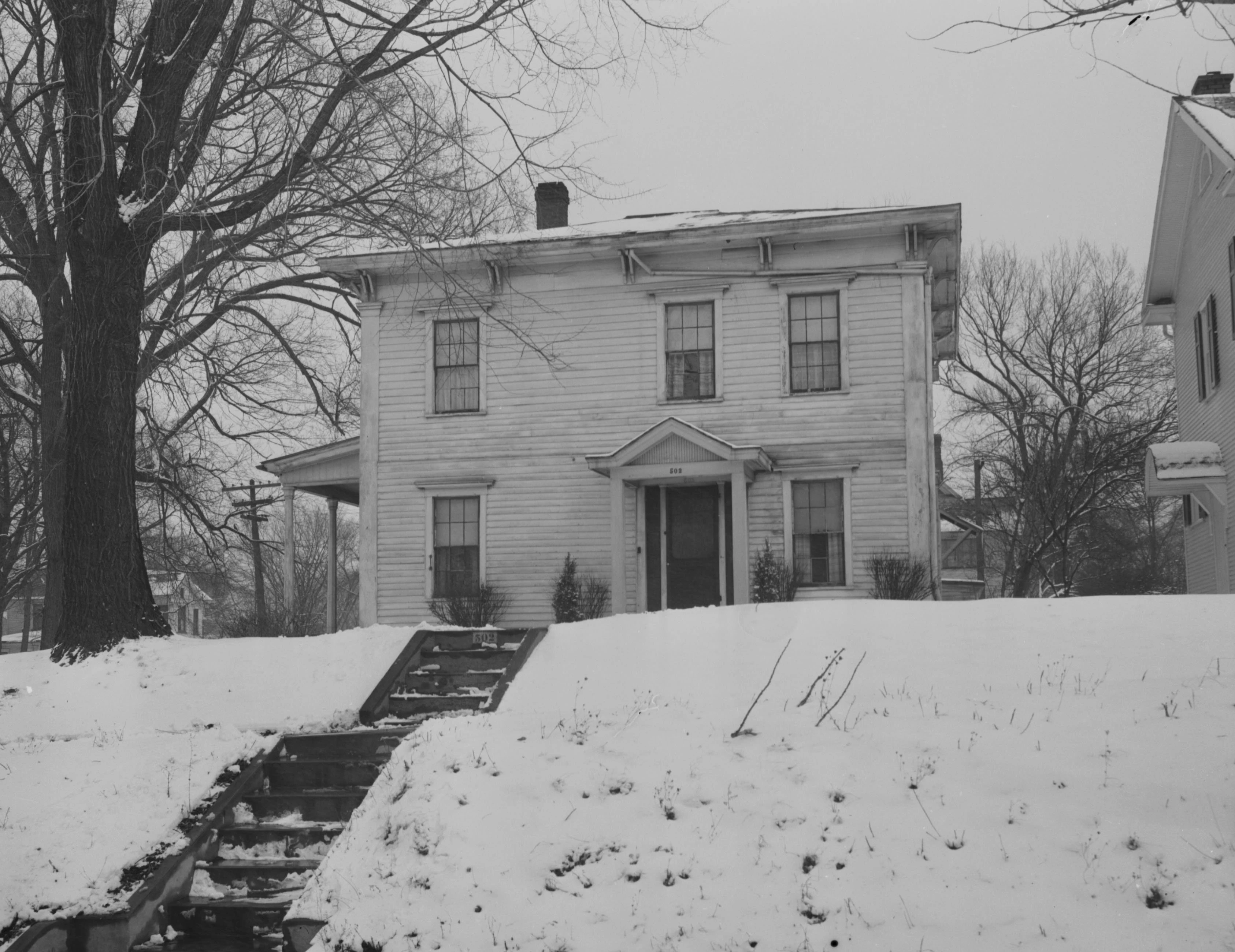Beginning in the 1960s, many fine, sturdy single-family homes dating from the 19th and early 20th centuries were unceremoniously bulldozed for Illinois State University off-campus housing. The greatest loss in this destructive—and at times unchecked—pattern was the 1856-1857 Jesse W. Fell house, located at 502 South Fell Avenue.
Born into a Pennsylvania Quaker family, Fell was 24 years old when he came to Central Illinois in 1832. He was the first lawyer in the new county seat of Bloomington, though he gave up a legal career in favor of land speculation and town development. He played an instrumental role in the establishment of the state’s first public institution of higher education (now Illinois State University), and is considered the founder of not only the Town of Normal, but a half-dozen other communities, including Clinton and El Paso in Central Illinois and Larchwood in the northwestern corner of Iowa.
In 1859, Fell cajoled his friend and political ally Abraham Lincoln to pen an autobiographical sketch in order to improve his name recognition and boost his prospects for the 1860 Republican nomination for president.
Fell built his two-story, wood frame Federal-style house to serve as the centerpiece of a triangle-size, fifteen-acre parcel of landscaped grounds bordered on the north by the Chicago & Alton Railroad (today Union Pacific and Amtrak), east by Broadway Avenue and south by Vernon Avenue. If one overlaid the estate on today’s reconfigured street layout, the house would’ve originally occupied an area south of Irving Street (which didn’t exist in Fell’s day) and west of Broadway Avenue.
The house was situated on high ground just southwest of the junction of the Illinois Central Railroad (today Constitution Trail) and the C&A. When Normal was first platted in 1854 it was known as North Bloomington or simply “The Junction.”
The design of the house is credited to Fell. Around the same time, Edwin C. Bakewell built a similar Italianate residence to the northwest. Later known as the Gregory House, it’s is a well-known local landmark today on the 600 block of North Main Street, north of University High School
Fell called his home and surrounding acreage “Greenwood,” though area residents (who were welcome to stroll the property on Sunday) preferred “Fell Park.” The attractive grounds were credited to William Saunders, a Scottish-born landscape designer from Philadelphia whose work included the Soldiers’ National Cemetery at Gettysburg, Penn.
Perhaps the best account of Greenwood comes from a detailed reminiscence of the place by Fell granddaughter Harriet Fyffe Richardson. “Around two sides of the property ran a picket fence painted red,” she recalled. “The southeast corner, occupying what would be the equivalent to a city block, was a deer park surrounded by an elaborate high picket fence, also painted red.” A “pretty little steep-roofed house or chalet” in the northwest corner offered shelter for the four or five deer Fell kept on the grounds.
The avenue running from the south gate to the house was lined with arbor vitae, and the grounds included apple, pear and peach trees; “quite extensive vineyards” of Concord, sweet Delaware, Catawba and other grape varieties; currant and gooseberry bushes; a “very large” strawberry patch; and two cows to provide butter and cream for the household. Outbuildings included a carriage barn and a playhouse for children.
Lincoln was said to be an occasional visitor to Greenwood, spending nights in a large room on the second floor. According to Harriet Richardson, other visitors included Owen Lovejoy, the abolitionist-turned-congressman, educator Horace Mann and poet William Cullen Bryant.
After financial reverses, Fell foreclosed on Greenwood and moved two blocks south to 702 South Broadway, and there he passed away in 1887 (that house still stands). After his death the old Greenwood grounds were platted into streets and residential lots, while the house was moved several hundred yards west along the 500 block of South Fell Avenue, where it remained until its untimely demise.
F.W. Dooley and his wife Laura Rhodes purchased the house in December 1913, making drastic changes to both the interior and exterior, including the removal of the cupola and a Fell-era 1½-story addition. The east and west side verandas were pulled off at a later date, giving the once-elegant structure a boxy, stripped-down look.
The last owner was Cushman Skinner, whose grandmother Lucile Heckethorn had earlier held the house for some thirty years. Skinner rented the historic but deteriorating place to ISU students, though by the mid-1970s he decided to leave it vacant after several kids skipped town, saddling him with unpaid rent and utility bills.
Around this same time, Kevin and Pamela Kennedy, a local couple with an interest in preservation, had the house placed on the National Register of Historic Places. It had previously appeared on the Historic American Buildings Survey of 1936 and the Illinois Historic Landmark Survey of the early 1970s, though both designations, like the National Register one, did not prevent the owner from tearing it down.
There were several proposals to save the house, but Skinner, for reasons unknown, seemed uninterested in any and all preservationist efforts. A group of prominent local residents, including the Rev. William Hammitt, ISU President Lloyd Watkins and Fell descendent Timothy Ives, held several meetings with Skinner’s attorney, but the two parties never reached a deal.
With little fanfare, the house came down in mid-August 1980. “Grooves and ruts from the tracks of heavy equipment are all that mark the lot,” noted The Pantagraph a week after a bulldozer completed its job.
Today, a nondescript student apartment complex stands in its place. One would be hard pressed to come up with a more painful preservation loss in all of Normal’s rich history.

